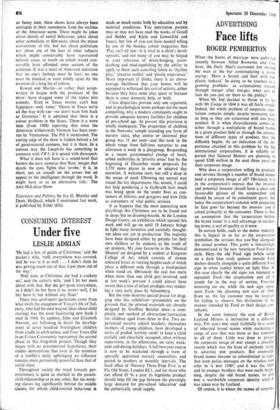Under five
CONSUMING INTEREST LESLIE ADRIAN
He had a box of paints at Christmas,' said the packer's wife, 'well, everywhere was covered, and he was in it as well . . . I didn't think he was getting much out of that; I put them out of the way.'
'Well now, at Christmas she had a cookery set,' said the cutter's wife, 'and I let her mess about with that. But she got paste everywhere, so I didn't let her have it no more—well, I let her have it, but without any flour.'
These two spoil-sport quotations come from what (with the exception of Troyat's life of Tol- story, who had his own wayout ideas about child rearing) was the most fascinating new book I read in 1968. Its authors, John and Elizabeth Newson, are following in detail the develop- ment of seven hundred Nottingham children from cradle to adolescence, and Four Years Old in an Urban Community represented the second phase in this long-term project. Though they began with no preconceived hypotheses, their studies demonstrate that even in the minutiae of a toddler's daily upbringing no influence remains more pervasively powerful than that of social class.
Throughout society the trend towards per- missiveness is quite as marked in the parent- child relationship as in any other. But the work- ing classes lag significantly behind the middle classes, for whom child-centred behaviour is made so much easier both by education and by material conditions. You SPECTATOR parents
may or may not have read the works of Gesell and Buhler and Klein and Lowenfeld and Isaacs; but few of you can have needed telling by one of the Sunday colour magazines that `Play isn't all fun—it is vital to a child's devel- opment,' and not many of you may be helped in your tolerance of drum-banging, paint- daubing and mud-squelching by the ability to apply to them such consoling labels as 'rhythm play,' creative outlets' and 'plastic experience.' More important (I think), there is an above- average likelihood that your homes will be equipped to withstand this sort of activity, either because they have some play space or because there is some domestic help, or both.
Class disparities provide only one argument, and in psychological terms perhaps not the most compelling, why a modern community ought to provide adequate nursery facilities for children of pre-school age. At present this provision is totally inadequate. The proportion of children in the Newsons' sample attending any form of nursery class, play centre or informal play group was 11 per cent—and this took in the whole range from full-time nurseries to one afternoon a week in a playgroup. Responding to a recent governmental change of heart, urban authorities in 'priority areas' had by the beginning of December made proposals for 1,779 more places in new or adapted day nurseries. A welcome start; but still a drop in the ocean of need. Elbowing my annual way round the toy departments this month, I could not help pondering a la Galbraith how much was being spent on the under fives as con- sumers of bibelots and gewgaws and how little as consumers of vital public services.
It so happens that the most interesting new playthings this Christmas are to be found not in shops but on drawing-boards. At the London Design Centre, an exhibition which opened this week and will go on until 18 January brings to light many inventive and carefully thought- out ideas not yet in production. The majority have been designed either by parents for their own children or by students as the result of set projects. My own favourite is the 'Musical Mounts' set designed by a student at Kingston College of Art, which consists of sixteen coloured boxes in varying heights each of which plays -a different note through a loudspeaker when stood on. Obviously the real fun starts when more than one child gets involved, and at last week's preview I could almost have sworn that a trio of infant prodigies was render- ing a very early piece by Schoenberg.
But the Com deserves special praise for drag- ging into this exhibition—presumably on the grounds that the printed materials are cleverly designed by Geoffrey Butcher msta—a com- pletely new method of abstraction/instruction for children aged from three to five. Two ex- perienced nursery school teachers, themselves mothers of young children, have developed a series of graded 'activity cards' to keep a child usefully and cheerfully occupied, often without supervision, in the afternoons, on rainy week- ends and during holidays. A full two-year course is now to be marketed through a team of specially appointed nursery counsellors and posted to mothers at monthly intervals. The head office of 'Nursery Three Four Five' is at 93a Old Street, London EC1, and for those who can afford £9 9s a year its ingenious product should help fill the gap between the pressingly large demand for pre-school 'education' and the pathetically small supply.


































 Previous page
Previous page